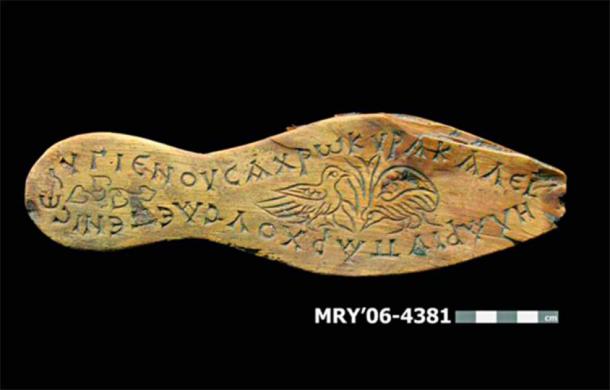
Byzantine-Era Sandals with Heartfelt Inscription Unearthed in Istanbul
Archaeologists have stumbled upon a remarkable discovery in Istanbul that has captured the attention of historians and fashion enthusiasts alike. Amidst a treasure trove of ancient artifacts, they discovered a pair of 1,500-year-old Byzantine-era lady’s sandals adorned with a heartwarming message inscribed in Greek. The message, which reads “Use in health, lady, wear in beauty and happiness,” adds an element of charm to this already remarkable discovery.
The discovery of these Byzantine-era sandals was just one small part of a booty of as many as 60,000 artifacts that have been uncovered in Istanbul’s ancient Harbor of Eleutherios since 2004. These priceless artifacts, are currently undergoing preservation at the Istanbul Archaeological Museum until a permanent home is found for them.
- King Tut Stepped on his Enemies: Learning from Tutankhamun’s Sandals
- Adidas of Ancient Rome: Ancient Fashion Unveiled with Discovery of Roman Shoe Hoard
The sandals were found along with a range of artifacts, but despite the impressive size of the collection, the pair of sandals has quickly become the museum's hottest attraction. Scholars believe that the sandals belonged to a Greek woman from the Byzantine Empire, according to a report published in Arkeonews. The discovery serves as a testament to the importance of the highly ambitious Marmaray project, a major infrastructure project taking place in Istanbul that has involved the construction of a railway tunnel under the Bosporus, connecting the European and Asian sides of the city.

Byzantine-era sandal with inscription unearthed in Istanbul. (History of Istanbul)
Love for Patterns and Cloth Revealed by Byzantine-Era Sandals
The Byzantine Empire was the continuation of the Roman Empire in its eastern provinces during Late Antiquity and the Middle Ages. It survived the fragmentation and fall of the Western Roman Empire in the 5th century AD and continued to exist for another thousand years until it fell to the Ottoman Empire in 1453. During most of its existence, the empire was the most powerful economic, cultural and military force in Europe.
The Byzantines loved color and patterns and exported richly patterned cloth, especially Byzantine silk, which was woven and embroidered for the upper classes, or resist-dyed and printed for the lower. Modesty was important, and most women appeared to be almost entirely covered by rather shapeless clothes. The footwear of the time is well represented in the excavation, with sandals, slippers and boots to the mid-calf being commonly found.

Byzantine clothing from circa 300 to 700 AD in Costumes of All Nations (1882). (Public domain)
The production of silk was a closely guarded secret of the Byzantines, and for centuries, they had a monopoly on the trade. They exported silk to the west, where it was highly valued and sought after by the wealthy and powerful. Clothing was an important marker of social status, and the wealthy often adorned their garments with precious stones, gold thread and intricate embroidery.
The color red, reserved for imperial use in male footwear, is actually by far the most common color for women’s shoes. Purses are rarely found and seem to have been created using textiles matching particular outfits, or perhaps tucked into the sash.

Besides the Byzantine-era sandals, tens of thousands of artifacts have been uncovered during excavations in Istanbul. (Gryffindor / CC BY-SA 4.0)
Istanbul Excavations Also Unearthed the Famed Harbor of Eleutherios
The excavation also found the first traces of civilizations from different periods. For example, the skeletons of the first Istanbulites were uncovered, along with 8,500-year-old footprints. The Harbor of Eleutherios (Theodosius), a port known in world literature, but of which no traces had previously been found, was also discovered. It was one of the ports of ancient Constantinople, built at the mouth of the Lycus River, and was the city’s major point of trade in Late Antiquity, reported The Greek Reporter.
The harbor was built in the late 4th century, during the reign of Theodosius I, and continued to be used until the 11th century. The area was later transformed for agricultural use due to the effects of upstream erosion and deposition. During Ottoman times it was entirely built over. In November 2005, workers on the Marmaray project discovered the silted-up remains of the Theodosius Harbor, which was then excavated.
- Mystery Man in High Leather Boots: How Did His Medieval Skeleton End Up in London’s River Thames?
- High Heels Were Originally Worn By Men
Archaeologists also uncovered traces of the city wall of Constantine the Great and the remains of over 35 Byzantine ships from the 7th to 10th centuries, including several Byzantine galleys, remains of which had never before been found. In addition, archaeologists uncovered the oldest evidence of settlement in Constantinople, with artifacts dating back to 6000 BC, including amphorae, pottery fragments, shells, pieces of bone and horse skulls. They even discovered nine human skulls mysteriously kept in a bag.
Istanbul has witnessed several civilizations, right from the Neolithic period (6500-5500 BC) to the Greeks and Romans, and eventually the Byzantines. In the ensuing religious clashes between Islam and Christianity over control of the Western Asian belt, the Ottomans took control in the 15th century and remained in power until the First World War.
Top image: Byzantine-era sandal with inscription unearthed in Istanbul. Source: Hurriyet Daily
By Sahir Pandey
References
Altuntas, L. 11 April 2023. “The Secret of the Shipwrecks at Theodosius Harbor: 1,600 Years Old Women’s Sandals and Comb” in Arkeonews. Available at: https://arkeonews.net/the-secret-of-the-shipwrecks-at-theodosius-harbor-1600-years-old-womens-sandals-and-comb/
Kokkinidis, T. 9 April 2023. “The 1,500-Year-Old Lady’s Sandals with Sweet Message in Greek” in Greek Reporter. Available at: https://greekreporter.com/2023/04/09/1500-year-old-sandals-greek/















